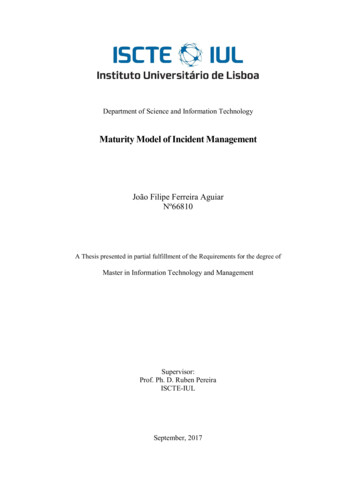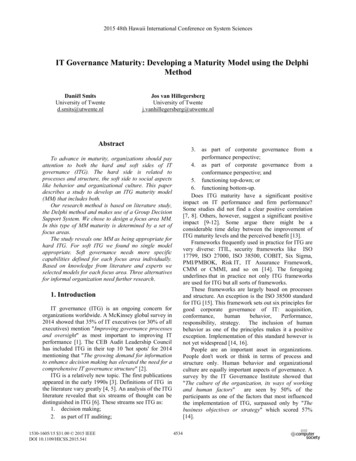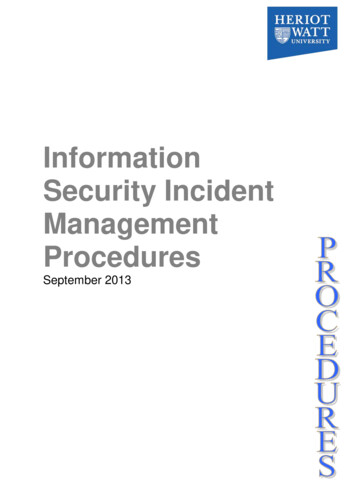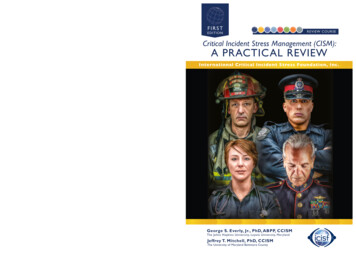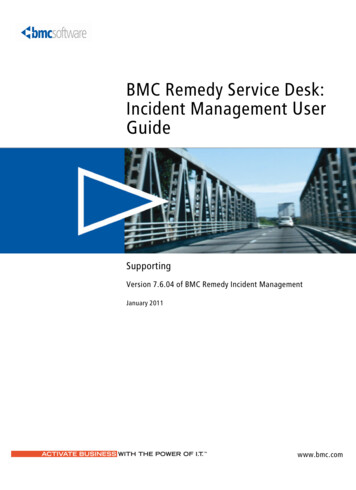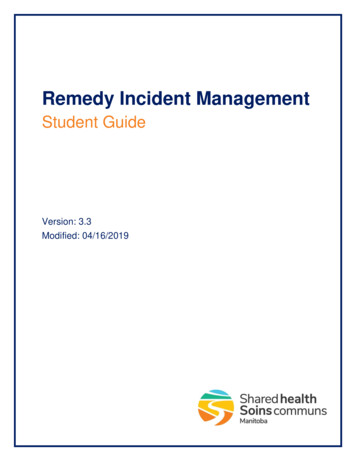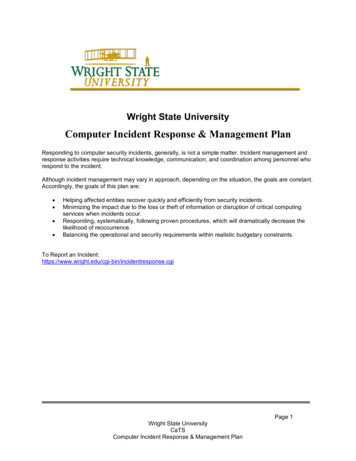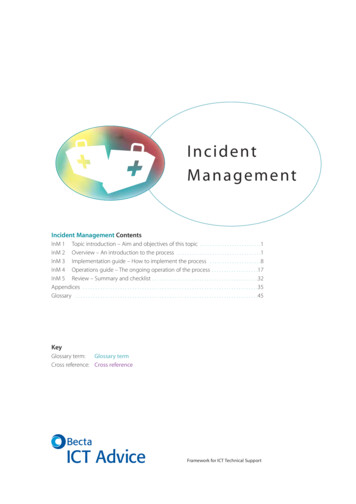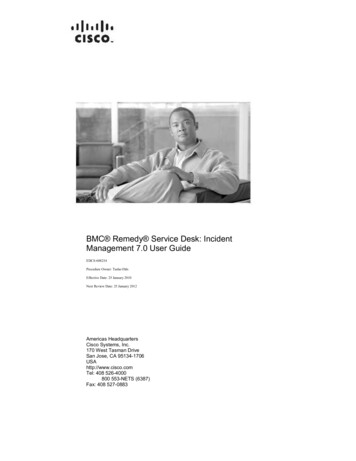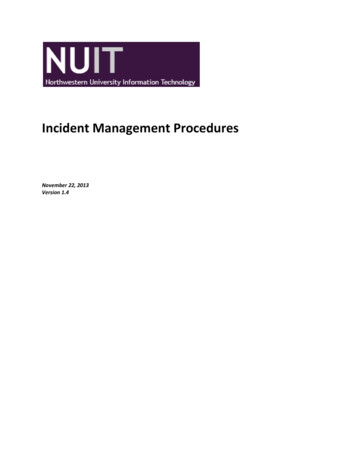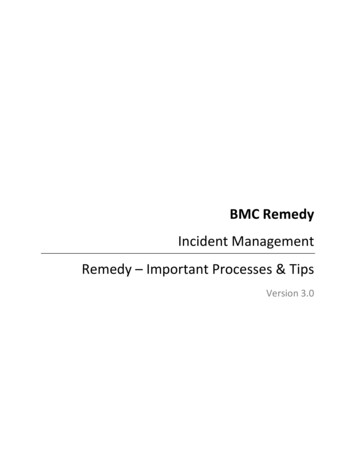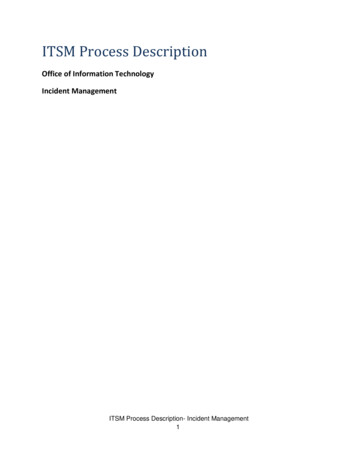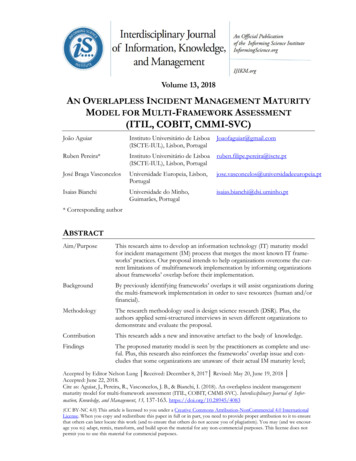
Transcription
Volume 13, 2018AN OVERLAPLESS INCIDENT MANAGEMENT MATURITYMODEL FOR MULTI-FRAMEWORK ASSESSMENT(ITIL, COBIT, CMMI-SVC)João AguiarInstituto Universitário de Lisboa(ISCTE-IUL), Lisbon, PortugalJoaofaguiar@gmail.comRuben Pereira*Instituto Universitário de Lisboa(ISCTE-IUL), Lisbon, Portugalruben.filipe.pereira@iscte.ptJosé Braga VasconcelosUniversidade Europeia, ia.ptIsaias BianchiUniversidade do Minho,Guimarães, Portugalisaias.bianchi@dsi.uminho.pt* Corresponding authorABSTRACTAim/PurposeThis research aims to develop an information technology (IT) maturity modelfor incident management (IM) process that merges the most known IT frameworks’ practices. Our proposal intends to help organizations overcome the current limitations of multiframework implementation by informing organizationsabout frameworks’ overlap before their implementation.BackgroundBy previously identifying frameworks’ overlaps it will assist organizations duringthe multi-framework implementation in order to save resources (human and/orfinancial).MethodologyThe research methodology used is design science research (DSR). Plus, theauthors applied semi-structured interviews in seven different organizations todemonstrate and evaluate the proposal.ContributionThis research adds a new and innovative artefact to the body of knowledge.FindingsThe proposed maturity model is seen by the practitioners as complete and useful. Plus, this research also reinforces the frameworks’ overlap issue and concludes that some organizations are unaware of their actual IM maturity level;Accepted by Editor Nelson Lung Received: December 8, 2017 Revised: May 20, June 19, 2018 Accepted: June 22, 2018.Cite as: Aguiar, J., Pereira, R., Vasconcelos, J. B., & Bianchi, I. (2018). An overlapless incident managementmaturity model for multi-framework assessment (ITIL, COBIT, CMMI-SVC). Interdisciplinary Journal of Information, Knowledge, and Management, 13, 137-163. https://doi.org/10.28945/4083(CC BY-NC 4.0) This article is licensed to you under a Creative Commons Attribution-NonCommercial 4.0 InternationalLicense. When you copy and redistribute this paper in full or in part, you need to provide proper attribution to it to ensurethat others can later locate this work (and to ensure that others do not accuse you of plagiarism). You may (and we encourage you to) adapt, remix, transform, and build upon the material for any non-commercial purposes. This license does notpermit you to use this material for commercial purposes.
Overlapless Incident Management Maturity Modelsome organizations are unaware that they have implemented practices of otherframeworks besides the one that was officially adopted.Recommendations Practitioners may use this maturity model to assess their IM maturity level befor Practitionersfore multi-framework implementation. Moreover, practitioners are also incentivized to communicate further requirements to academics regarding multiframework assessment maturity models.Recommendations Researchers may explore and develop multi-frameworks maturity models for thefor Researchersremaining processes of the main IT frameworks.Impact on SocietyThis research findings and outcomes are a step forward in the development of aunique overlapless maturity model covering the most known IT frameworks inthe market thus helping organizations dealing with the increasing frameworks’complexity and overlap.Future ResearchOverlapless maturity models for the remaining IT framework processes shouldbe explored.KeywordsIT framework, maturity model, DSR, incident management, overlap, ITIL, COBIT, CMMIINTRODUCTIONInformation Technology (IT) has become crucial to the support, sustainability, and growth of mostbusinesses (Pereira, Mira da Silva, & Lapão, 2014), by supporting existing business strategies as wellas new strategies (Henderson & Venkatraman, 1993). IT has ceased to act simply as a supportive roleand has taken on a central position within organizations. Currently, having an IT department is notenough to ensure that an organization is technologically successful.Due to the high number of services and the different types of organizations, IT grew rapidly andwidely. At the same time, IT service managers are under pressure to reduce costs while helping theorganization to generate revenue and quickly deliver cost effective services to their customers(Gacenga, Cater-Steel, & Toleman, 2010).Many IT frameworks have been proposed to help organizations manage and govern IT. InformationTechnology Infrastructure Library (ITIL), Control Objectives for Information and Related Technologies (COBIT), and Capability Maturity Model Integration for Services (CMMI-SVC) are among themost used and accepted IT Frameworks in the market (Barash, Bartolini, & Wu, 2007; InformationTechnology Governance Institute, 2007; Sekhara, Medromi, & Sayouti, 2014; Software EngineeringInstitute, 2010; Yoo et al., 2006).Yet, in spite of the growing importance of IT frameworks, several problems still remain. For example, IT frameworks are seen as very generic and very complex (De Haes, Van Grembergen, &Debreceny, 2013). Some of these IT frameworks are not mutually exclusive and can be combined inorder to provide a powerful IT framework (Information Technology Governance Institute, 2008) butmost of them overlap each other (Pereira & Mira Da Silva, 2012b). This becomes a major issue sincedifferent frameworks are often used as complementary and most of the times simultaneously, whichmeans that parallel projects imply a duplication of investments, costs, and human resources (Gama,Sousa, & da Silva, 2013).Despites IT frameworks importance, they have also been criticized, and maturity models are seen as away to overcome such problems (Trinkenreich & Santos, 2016). Maturity models in IT managementhave been proposed since at least 1973 (Rocha & Vasconcelos, 2004). More than one hundred different maturity models have been proposed (De Bruin et al., 2005) but most are too general and, as a138
Aguiar, Pereira, Vasconcelos, & Bianchiresult, are not well defined or documented (Becker, Knackstedt, & Pöppelbuß, 2009). Plus, despitesome researchers pointing out that these IT frameworks overlap each other (Sahibudin, Sharifi, &Ayat, 2008), current maturity models do not address the overlap issue.Due to the monetary, operational, and image impact that incident management (IM) process canbring to an organization, it is usually one of the most adopted by organizations (Alshathry, 2016).Plus, it is also a key element for IT support (Cusick & Ma, 2010). However, IM implementation islong, complex, expensive, and often fails (Ghrab, Ketata, Loukil, & Gargouri, 2016). Failure of proper operation of the IM process can result in ongoing interruptions by IT support technicians, poorlydefined resolution priorities, poor management information, and forgotten, poorly managed events.For example, one of the ultimate measures of an IT support organization’s success is the amount oftime it takes to resolve an incident (Barash et al., 2007). This means that IM can shape how customers see the entire organization.An effective incident information management system needs to deal with several organizational challenges to support heterogeneous distributed incident data and to enable decision makers to detectanomalies and extract useful knowledge for problem solving. In this context, decision makers shouldevaluate the risks, select the appropriate alternatives during an incident, and provide differentiatedservices to satisfy the requirements of different incident management phases (Peng, Zhang, Tang, &Li, 2011).As previously stated, IT frameworks can help organizations in such implementation. However, ITframeworks are complex (De Haes et al., 2013), generic (De Haes et al., 2013) and overlap each other(Information Technology Governance Institute, 2008; Pereira & Mira Da Silva, 2012b). Maturitymodels are seen as a possible mechanisms to overcome frameworks problems but they are seen asincomplete (Becker et al., 2009).As previously stated, IT has become essential for organizations but it also brings complexity. SeveralIT frameworks exist to help organizations define and implement the most relevant IT processes.Similarly, some IT maturity models have also been created (some linked with IT frameworks) to helporganizations prioritize the IT processes implementation. IM process has been pointed as one of themost early adopted processes (quick win). However, most of these frameworks and maturity modelsoverlap each other leading to a waste of resources. On behalf of such evidences and grounded onthe need of further investigation about multi-frameworks implementation and how they can be managed and measured (De Haes et al., 2013), this research intends to provide further information on thefollowing research question: Is it possible to develop an overlapless and complete IT Maturity Modelfor Incident Management process?The remainder of this article is organized as follows. The next section provides necessary background about the main IT frameworks and maturity models. Then the research process is presented.Followed by the proposed maturity model grounded on the main IT frameworks for the IM process.Information about the demonstration and evaluation is presented in the section Demonstration andEvaluation. The Discussion section describes the validation of this research contribution. Last butnot least, the final section exposes the main conclusions and provides a brief overview of possiblenext steps of this investigation.LITERATURE REVIEW AND RELATED WORKIT F RAMEWORKSMany IT frameworks have been created to manage, measure, and align IT objectives with the organization’s objectives. Among the most known, important, and used IT management frameworks, ITIL,COBIT and CMMI-SVC stand out. These three IT frameworks are seen as the most used in practice(Barash et al., 2007; Information Technology Governance Institute, 2007; Sekhara, Medromi, &Sayouti, 2014; Software Engineering Institute, 2010; Yoo et al., 2006)139
Overlapless Incident Management Maturity ModelITIL is a set of publications on best practices (Office of Government Commerce, 2007b) and oneof the most widely accepted approaches to IT service management in the world (Office ofGovernment Commerce, 2007a; Saarelainen & Jantti, 2016). The ITIL framework has been used byorganizations in all industries and sectors, including large, medium, and small organizations. ITIL canbenefit any organization that provides an IT service management (ITSM) product or service. However, ITIL requires too much change in organizational culture, and organizations tend to lack experienced consultants in ITIL (Bovim, Johnston, Kabanda, Tanner, & Stander, 2014).COBIT is a framework for developing, implementing, monitoring, and improving IT governance andits management practices as well as another of the most adopted worldwide for such purpose. Thisframework is published by the IT Governance Institute and the Information Systems Audit and Control Association (ISACA) (2012). The COBIT 5 processes are split into governance and managementareas.CMMI is a best practice framework (Software Engineering Institute, 2010). The CMMI model doesnot describe the processes themselves; it describes the characteristics of good processes, thus providing guidelines for organizations developing or honing their own sets of processes. According to theCMMI framework, a specific goal describes the unique characteristics that must be present to satisfythe process area. A specific practice is the description of an activity that is considered important inachieving the associated specific goal. The specific practices describe the activities that are expectedto result in achievement of the specific goals of a process area.Besides describing the most important, used, and relevant IT Frameworks, this section also intendsto present a brief analysis of them (Table 1). All frameworks seem to have information about the IM,which make them possible suitable frameworks to provide inputs to our proposal.Table 1. IT Frameworks ComparisonITIL V3COBIT 5CMMI-SVCFoundedOGCISACASoftware Engineering Institute (SEI)Last UpdateJuly 2011April 2012November 2010FocusServiceServiceServiceIMYesYesYesName ofProcessIncident ManagementManage Service Requests andIncidentsIncident Resolution and PreventionNumber ofProcesses263724IT M ATURITY M ODELSBesides the usefulness and relevance of these IT frameworks, they are also seen as complex and difficult to implement by practitioners. As can be seen at Table 1, these IT frameworks have dozens ofprocesses and probably hundreds (or even thousands) of practices. Therefore, some of these ITframeworks have been developing their own maturity models in order to guide and help their users inthe framework implementation.A maturity model consists of a sequence of maturity levels for a class of objects. It represents ananticipated, desired, or typical evolution path of these objects shaped as discrete stages. Typically,these objects are organizations or processes (Becker et al., 2009).Therefore, organizations use maturity models to have their methods and processes evaluated in accordance with good management practices and with a set of external parameters. Maturity is indicat-140
Aguiar, Pereira, Vasconcelos, & Bianchied by the assignment of a particular maturity level. By doing it, organizations taking advantage ofmaturity models simplicity which facilitates their understanding and communication as well as thefact that they may be used for benchmarking. Considering the purpose of this research, the followingparagraphs will analyze the most relevant maturity models. (Both scientific and practitioner’s maturitymodels will be discussed.)One of the most known and included in COBIT 5 documentation is a maturity model that can beused by organizations to assess COBIT processes maturity (Information Systems Audit and ControlAssociation,
Overlapless Incident Management Maturity Model 140 ITIL is a set of publications on best practices (Office of Government Commerce, 2007b) and one of the most widely accepted approaches to IT service management in the world (Office of Government Commerce, 2007a; Saarelainen & Jantti, 2016). The ITIL framework has been used byCited by: 7Publish Year: 2018Author: João Aguiar, Rúben Pereira, José Braga de Vasconcelos, Isaias Bianchi
